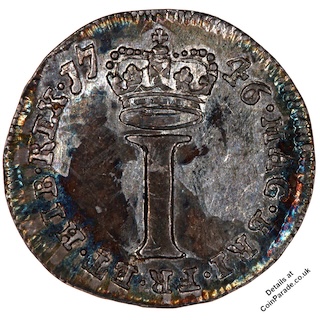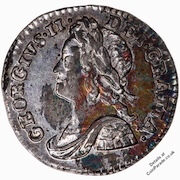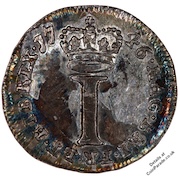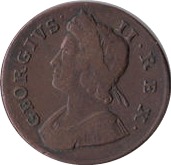
 The 1746 Maundy Penny - George II
The 1746 Maundy Penny - George IISilver Maundy Penny of King George II, minted in 1746 by the Royal Mint. No Copper pennies were minted under George II (they did mint halfpennies and farthings).
Read more about Maundy Money.
Diameter 12mm and weighs 0.49g. There are 1746/3 restrikes.
The Obverse, by John Croker, is the laureated and draped bust of George II facing left. Legend is "GEORGIVS II DEI GRATIA".
The edge is plain.
 The Reverse, by John Sigismund Tanner, shows crowned Roman numeral 'I'. Legend is "MAG BRI FR ET HIB REX" with date divided around top.
The Reverse, by John Sigismund Tanner, shows crowned Roman numeral 'I'. Legend is "MAG BRI FR ET HIB REX" with date divided around top.Image credit: Museums Victoria
Mintage: Not known
Minted at The Royal Mint
SCBC: 3715A
More information (monarch, year, mint, country, category) can be found below coin listings.
Below are some coins currently being offered on eBay. As an eBay Partner, We may be compensated if you make a purchase.
List items on:
List items on:
Remember 1746 ?
Monarch was George II. Prime Minister is Henry Pelham (Whig). Bonnie Prince Charlie (Charles Edward Stuart) occupies Stirling as part of the Jacobite rising. Samuel Johnson is contracted to write 'A Dictionary of the English Language'.
George II (1727-1760)
 George II was King of Great Britain and Ireland, Duke of Brunswick-Lüneburg and Prince-elector of the Holy Roman Empire from 11 June 1727 until his death. He was son of George I.
George II was King of Great Britain and Ireland, Duke of Brunswick-Lüneburg and Prince-elector of the Holy Roman Empire from 11 June 1727 until his death. He was son of George I.George was the last British monarch to be born outside Great Britain; he was born in Germany. There were a few arguements about various claims to the throne and not all of George's family supported him. George's eldest son Frederick died in 1751 and George was eventually succeeded by his grandson, George III.
The regnal years for George II coins were:
1729:TERTIO; 1731:QVARTO; 1735:OCTAVO; 1738:DVODECIMO; 1741:DECIMO QVARTO; 1746:DECIMO NONO; 1748:VICESIMO SECVNDO; 1753:VICESIMO SEXTO.
Category: Penny
The Penny is one of the most famous British coins. The coin itself has been around since 600AD and at various times has been struck in silver, copper and bronze. Originally split into halfpennies and farthing, it is now itself the least denomination coin currently in circulation. Made from copper (actually copper plated steel). Originally there were 12 pennies in one shilling and 240 pennies in £1; since decimalisation in 1971 there are 100 new pence in one pound.
Composition: Early pennies were Silver, then Copper, Bronze and Copper coated steel.
Collection: Maundy Money
Maundy Money are coins traditionally given out by the Monarch as a gift to the poor at Royal Maundy. The ceremony, which is associated with Christianity, is held on Maundy Thursday which is the day before Good Friday. The Maundy set consists of four coins, denominated one penny, two pence, three pence and four pence. The number of sets given out to each man and woman is equivalent to the age of the Monarch in years.
Which Mint: The Royal Mint
The Royal Mint is the designated place for the UK to mint coins. It dates back well over 1000 years and is a Government-owned company. Formed in the reign of Alfred the Great about the year 886, during the period 1279-1812 it was generally referred to as The Tower Mint as it was housed at the Tower of London. The Master of The Royal Mint has included famous figures such as Sir Isaac Newton.
Since 2010 it has operated as Royal Mint Ltd, a company owned by HM Treasury, under an exclusive contract to supply all coinage for the UK although it also produces medals and coins for other countries. It is currently located at Llantrisant, Wales.
Country of Origin: United Kingdom
The United Kingdom (UK) is the Union of England, Scotland, Wales and Northern Ireland. It is often refered to as Great Britain (GBR). It has a long, rich history. The orignal coinage was Pounds, Shillings and Pence but since decimalisation on 15 February 1971, it is £1 = 100p, that is One Pound = 100 pence. The coinage of the UK is also a long history, the Royal Mint being established as long ago as 886AD when coins were hammered. Today there is perhaps 30 billion coins in circulation, and many (numismatic) collectors coins and sets are issued frequently in gold, silver and other metals.








